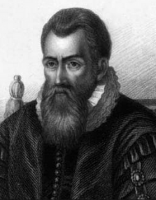










John Napier (1550—1617), Scottish mathematician and theological writer who originated the concept of logarithms as a mathematical device to aid in calculations.
Early life
At the age of 13, Napier entered the University of St. Andrews, but his stay appears to have been short, and he left without taking a degree.
Little is known of Napier’s early life, but it is thought that he traveled abroad, as was then the custom of the sons of the Scottish landed gentry. He was certainly back home in 1571, and he stayed either at Merchiston or at Gartness for the rest of his life. He married the following year. A few years after his wife’s death in 1579, he married again.
Theology and inventions
Napier’s life was spent amid bitter religious dissensions. A passionate and uncompromising Protestant, in his dealings with the Church of Rome he sought no quarter and gave none. It was well known that James VI of Scotland hoped to succeed Elizabeth I to the English throne, and it was suspected that he had sought the help of the Catholic Philip II of Spain to achieve this end. Panic stricken at the peril that seemed to be impending, the general assembly of the Scottish Church, a body with which Napier was closely associated, begged James to deal effectively with the Roman Catholics, and on three occasions Napier was a member of a committee appointed to make representations to the King concerning the welfare of the church and to urge him to see that “justice be done against the enemies of God’s Church.”
In January 1594, Napier addressed to the King a letter that forms the dedication of his Plaine Discovery of the Whole Revelation of Saint John, a work that, while it professed to be of a strictly scholarly character, was calculated to influence contemporary events.
The publication of this work, Napier seems to have occupied himself with the invention of secret instruments of war, for in a manuscript collection now at Lambeth Palace, London, there is a document bearing his signature, enumerating various inventions “designed by the Grace of God, and the worke of expert craftsmen” for the defense of his country. These inventions included two kinds of burning mirrors, a piece of artillery, and a metal chariot from which shot could be discharged through small holes.
Contribution to mathematics
Napier devoted most of his leisure to the study of mathematics, particularly to devising methods of facilitating computation, and it is with the greatest of these, logarithms, that his name is associated. He began working on logarithms probably as early as 1594, gradually elaborating his computational system whereby roots, products, and quotients could be quickly determined from tables showing powers of a fixed number used as a base.
His contributions to this powerful mathematical invention are contained in two treatises: Mirifici Logarithmorum Canonis Descriptio (Description of the Marvelous Canon of Logarithms), which was published in 1614, and Mirifici Logarithmorum Canonis Constructio (Construction of the Marvelous Canon of Logarithms), which was published two years after his death. In the former, he outlined the steps that had led to his invention.
Logarithms were meant to simplify calculations, especially multiplication, such as those needed in astronomy. Napier discovered that the basis for this computation was a relationship between an arithmetical progression—a sequence of numbers in which each number is obtained, following a geometric progression, from the one immediately preceding it by multiplying by a constant factor, which may be greater than unity (e.g., the sequence 2, 4, 8, 16 . . . ) or less than unity (e.g., 8, 4, 2, 1, 1/2 . . . ).
In the Description, besides giving an account of the nature of logarithms, Napier confined himself to an account of the use to which they might be put. He promised to explain the method of their construction in a later work. This was the Construction, which claims attention because of the systematic use in its pages of the decimal point to separate the fractional from the integral part of a number. Decimal fractions had already been introduced by the Flemish mathematician Simon Stevin in 1586, but his notation was unwieldy. The use of a point as the separator occurs frequently in the Construction. Joost Burgi, the Swiss mathematician, between 1603 and 1611 independently invented a system of logarithms, which he published in 1620. But Napier worked on logarithms earlier than Burgi and has the priority due to his prior date of publication in 1614.
Although Napier’s invention of logarithms overshadows all his other mathematical work, he made other mathematical contributions. In 1617 he published his Rabdologiae, seu Numerationis per Virgulas Libri Duo (Study of Divining Rods, or Two Books of Numbering by Means of Rods, 1667); in this he described ingenious methods of multiplying and dividing of small rods known as Napier’s bones, a device that was the forerunner of the slide rule. He also made important contributions to spherical trigonometry, particularly by reducing the number of equations used to express trigonometrical relationships from 10 to 2 general statements. He is also credited with certain trigonometrical relations—Napier’s analogies—but it seems likely that the English mathematician Henry Briggs had a share in these.